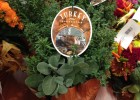Is There Enough Food on Your Thanksgiving Table to Share?

When someone mentions Thanksgiving, most of us think of an overabundance of food: turkey, sweet potatoes, casseroles, stuffing, pumpkin pie, apple pie…and on and on. It’s a time we’re thankful for all that we have.
But for nearly 15% of households, this year has been difficult. So beyond being thankful, it’s a great time to put these feelings into action by sharing with others.
The United States Department of Agriculture just released the results of their annual survey describing food insecurity in the U.S. The term “food insecurity” describes a limited access to adequate food because of a lack of money or other resources. In 2008, 17 million (14.6%) American households were food insecure at some time during the year. This means that more than 1 out of every 7 American households faced food insecurity. 6.7 million (5.7%) American households had very low food security meaning one or more household members reduced their food intake and had their eating patterns disrupted. These rates are the highest recorded since 1995 when the first national survey was conducted. (Household Food Security in the United States, 2008. http://www.ers.usda.gov/publications/err83/)
So as you’re planning your Thanksgiving shopping, why not add to the list a few extra items for your local food bank. If you don’t know of any food banks in your area, you can google “Food Bank, Your City, State”. Our local food bank holds an annual turkey drive to collect frozen turkeys to provide to families in need. They also are in need of volunteers to help sort and stock donations.
As our economy has suffered, so have our local food pantries. Donations are down and many are finding it harder and harder to provide for the increasing need in their community. Many rely on holiday donations to provide food for a good part of the year. Donating food is an easy way to help those in need.

Here are some common items needed by food pantries:
- Canned fruit (preferably packed in its own juice)
- Canned vegetables (preferably low sodium)
- Canned or dried beans
- Canned meals (stew, chili, soup)
- Canned tuna/poultry/meat
- Peanut butter
- 100% fruit juice in single serve boxes
- Packaged pasta and rice
- Packaged meals




